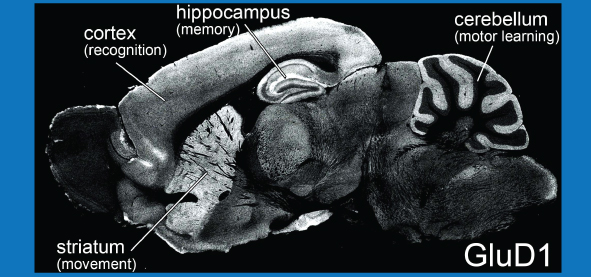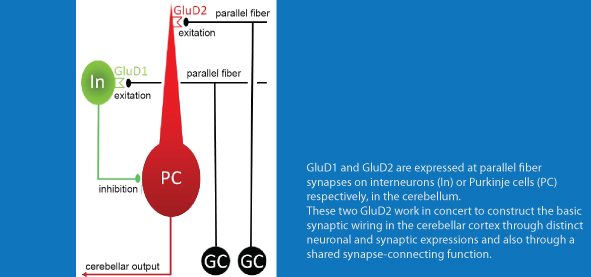Enriched expression of GluD1 in higher brain regions and its involvement in parallel fiber-interneuron synapse formation in the cerebellum
Research Press Release | June 09, 2014
-
 In the adult mouse brain, GluD1 is richly expressed in neural regions involving higher brain functions, such as the cortex (recognition), hippocampus (memory), striatum (movement), amygdala (emotion), and cerebellum (motor learning).
In the adult mouse brain, GluD1 is richly expressed in neural regions involving higher brain functions, such as the cortex (recognition), hippocampus (memory), striatum (movement), amygdala (emotion), and cerebellum (motor learning). -

| Press Release | ||
|---|---|---|
| Key Points |
・We developed sensitive and specific histochemical probes to visualize expression of the glutamate receptor GluD1, which is a likely location to find the genes that affect schizophrenia, bipolar disorder, major depressive disorder, and autism spectrum disorder. ・Using the histochemical probes, we demonstrated enriched expression of GluD1 in higher brain regions involving recognition, movement, emotion, and memory, and addressed its localization at particular synaptic circuits in the cerebellum. ・Furthermore, we found that the number of the cerebellar synapses was significantly reduced in mutant mice lacking GluD1 gene, indicating that GluD1 plays a key role in synapse formation. |
|
| Overview | Glutamate is the major excitatory transmitter in the brain, and plays key roles in generation and transmission of neural information, plasticity of brain functions, and synaptic circuit development. Among glutamate receptors mediating these functions, there is a cryptic family of the GluD, which has lost binding sites for glutamate and ion channel properties. So far, GluD2, one of two GluD family members, has been intensively investigated by enriching GluD2 in cerebellar Purkinje cells and regulating structural and functional connectivity of parallel fiber-Purkinje cell synapses. Mutations of the GluD2 gene (grid2) in humans and mice manifest cerebellar motor disorders, such as ataxia and nystagmus; however, information such as synaptic expression to molecular function is not known for GluD1. This research focused on this orphan receptor, and we were able to prove that there is enriched expression in higher brain regions such as the cerebrum and cerebellum, and that it strengthens synaptic connectivity on a molecular level.
This study was published in the Journal of Neuroscience (volume 34:, page 7412-7424, 2014), an official journal of the Society for Neuroscience, on May 28, 2014 https://www.jneurosci.org/content/34/22/7412.abstract?etoc), and was selected to feature in This Week in the Journal of this volume. This study was supported by CREST of the JST Agency and in part through Grants-in-Aid for Scientific Research and the Grant for “Integrated research on neuropsychiatric disorders” carried out under the Strategic Research Program for Brain Sciences, both provided by the Ministry of Education, Culture, Sports, Science and Technology of Japan. |
|
| Inquiries |
Masahiko Watanabe, Professor of Anatomy, Graduate School of Medicine, Hokkaido University TEL: +81-11-706-5032 FAX: +81-11-706-5031 E-mail:watamasa@med.hokudai.ac.jp Anatomy and Embryology website, 解剖学講座 解剖発生学分野 (in Japanese) https://aande.hokkaido.university/ |
|
|
Japanese Link |
精神神経疾患と強く関連するグルタミン酸受容体 GluD1 は高次脳領域に豊富に発現し,シナプス形成を制御する | |
| Publications | The Journal of Neuroscience (2014.5.28) | |
